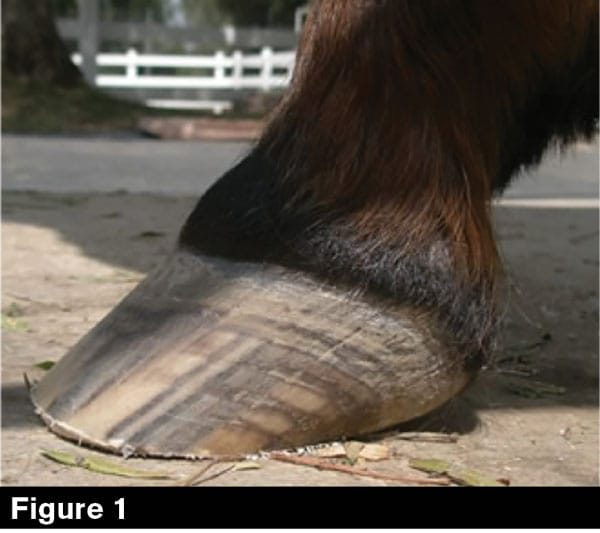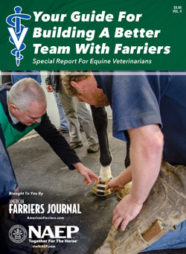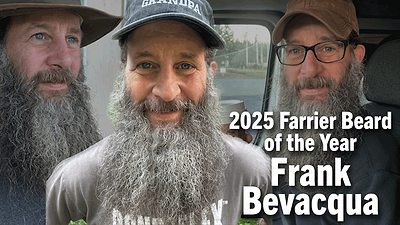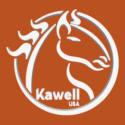High-low feet are disproportionate in that one foot is higher than the other. Since the feet are so dissimilar, each have their own characteristics.
The low foot typically is a broader, more rounded, fuller hoof. Its characteristics might include:
- Bull-nosed dorsal wall.
- Crushed, under-run heel.
- Posterior bruising.
- Broad, prolapsed frog.
- Collapsed bars.
- Preferred lead.
“The horse will often have a broad, bulbous frog,” says Hall of Fame farrier Danvers Child. “Some people refer to it as a prolapsed frog. In addition to collapsed bars, they will run laterally. I find that it runs about 70% that the low side is the left foot and high side is the right.”
The high foot typically is steep and clubby. Its characteristics might include:
- Toe flare, a dish and/or a crack.
- Anterior bruising.
- Contracted, hooky heel.
- Recessive, thrushy frog.
- Chronic shoe pulling.
- Unwillingness on lead.
“You’ll often see a little halo around the coffin bone,” Child says. “It’s a yellowish look to the anterior portion of the foot. I identify that as chronic bruising. It also can have a recessive, thrushy frog in this foot but not the others. The horse will have very little ground contact and usually if they’re going to pull a shoe, they’re going to pull it on the steep foot.”
Both feet tend to take on different appearances, though, depending on whether they are shod. When bare, the heels run forward on the low foot, while they are stacked on the steep foot (Figure 1). The horse also often dubs or breaks off the toe on the steep foot. When shod, farriers often overprotect the foot. Combine that with a longer cycle and the differences become more apparent.
“You’ll get a little bull nosing over the low foot and dishing on the high foot,” Child says. “It’s pretty obvious what happens to the low foot. We see that heel crushed, it’s run up and it takes a lot of stress.”
The damage to the high foot is not as obvious on the outside. Yet, it’s apparent radiographically.
“We see obvious capsular damage on the low foot,” he says. “When we start looking inside the high foot, then we see that we have pedal osteitis issues, and it’s torturing the anterior portion of the foot as much as it’s torturing the posterior portion of the other side (Figure 2).”

Damage to the high foot is apparent radiographically. While the low foot damages the posterior portion, the high foot typically damages the anterior.
Shoeing & Trimming
Child’s approach to trimming and shoeing has significantly evolved since he started shoeing in the 1970s. Like many farriers, he was taught to match feet, make the angles 55 degrees and perimeter fit the shoe.
Now, rather than match mismatched feet, Child shoes each foot individually utilizing hoof mapping.
“There are various ways of mapping feet — the center of rotation, Duckett’s dot, Duckett’s bridge, ELPO systems,” he says. “It doesn’t matter what map you use, as long as you have some systematic approach for getting your feet to work together and a map system that allows you to do that. I’m old school, so I tend to use Duckett’s dot and Duckett’s bridge.”
When trimming and shoeing a high-low horse, Child re-emphasizes the importance of recognizing that there are significant differences in the two feet. One foot is narrow and the other is full. The frog on the steep side is recessive and there is a tremendous amount of mass in front of it that’s not present in the low foot.
“The bars on the low-side foot are running laterally and the seat of corn has moved forward,” Child says. “The heels are actually functioning up near the heel quarter instead of back at the buttress of the foot. Whereas, on the high side, there are strong, straight bars that are coming back and running pretty true.”
Child points out that there are two main differences among farriers — one group fits feet, while the other places shoes. When it comes to shoeing high-low horses, Child fits in both categories because he fits one foot and places on the other.
“To get breakover and proportions right, I have to pull the foot back on the steep side as much as I can,” he says. “It’s so counterintuitive for me. I struggled and fought against it because it’s already a half-a-size smaller. Now I’m saying, ‘I’m going to pull it back and put a smaller shoe on it.’”
When trimming the heels on the high foot, Child refers to how far back he has placed breakover.
“When I set the 50/50 ratio while using Duckett’s dot, and I bring the shoe back ¼ inch, I can take another ¼ inch of heel off without bringing that horse up and raising him at the heels,” he explains. “And, after about two or three cycles, it starts to look a bit more normal.”
It’s important to take into consideration whether the high foot has a dish. Child says that he used to pad the high foot. Now, he recognizes the importance of leaving foot rather than taking it away.
“If we measure the feet before we start, we’ll usually find that is a shorter foot at the very beginning because we have to work around the dish to get our measurement,” he says. “It’ll be 1/8 inch to ¼ inch shorter already before you ever do anything to the foot. Then it has more concavity in it, so it encourages us to trim it more from the bottom. All of a sudden, we’ve exaggerated something that was already a problem. You have to take that dish into consideration and work with it.”
Child often is able to go up a little in shoe size because the horse is starting to utilize the high foot.
“When the horse starts using that steep side, it’s no longer torturing the low side,” he says. “The horse is designed to be heavy on the forehand. It’s the reason it doesn’t look like a tyrannosaurus rex. The more we can get them to utilize that steep side, balance their weight and be more symmetrical, the less they’re getting tortured on the low side. And, so I get it set back, the horse starts taking stress off of that low side and we get recovery in the caudal aspect of the low foot.”
Horses work on diagonals, so when there’s a disparity in the right front, there will be a diagonal disparity in the left hind — although, it might not be as obvious.
“It’s not going to jump out to you as much, but the same adjustments that you’re making in the front, you’ve got to make diagonally and behind,” Child says. “When you start measuring and evaluating these horses, you’ll see that your breakover has run forward. Your heels are a little crushed on that diagonal hind. So, you can’t forget to pay attention to the hinds.”
Gain more insight by reading "Trimming and Shoeing Strategies for High-Low Feet" in the July/August 2019 issue of American Farriers Journal.








